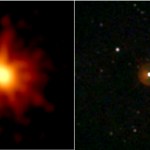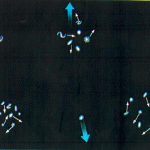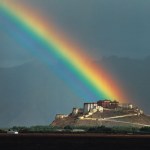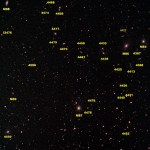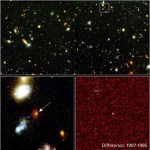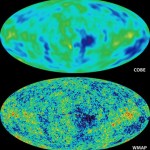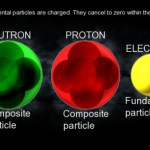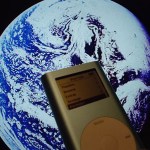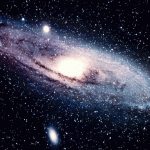
Those of you who keep up with your news may have seen this headline on CNN last week: Star Explodes Halfway Across Universe. What they're talking about is a Gamma-Ray Burst, which was so bright that, despite being 7.5 billion light years (that's 2.3 Gpc) away, it was still visible on Earth with the naked eye. From the article:
The aging star, in a previously unknown galaxy, exploded in a gamma ray burst 7.5 billion light years away, its light finally reaching Earth early Wednesday.
This is the sort of thing that the SWIFT satellite was designed to detect, pinpoint, and then tell Earth-based…
Remember the TV show Saved By The Bell? It was a high school comedy that was popular when I was in Junior High, and it was, of course, completely preposterous and cheesy. Like what you'd get if you married Beverly Hills: 90210 with Fast Times at Ridgemont High, and then cleaned it up to make it G-rated. There were two long-time couples, Zack (the blond preppie) and Kelly (the hot cheerleader in the sundress), and Jessie (the frizzy-haired neurotic) and Slater (the macho/sensitive latino).
Well, Jessie (Elizabeth Berkley), the frizzy-haired girl on the left, is finally back on TV hosting…
This was the third and final piece of the puzzle that led to the acceptance of the Big Bang and the rejection of all alternatives: the discovery of the background radiation left over from the Big Bang.
The "leading theory" before this was discovered was the Steady-State theory. Sure, they knew of Hubble Expansion. But they hemmed and hawed and said, "well, the Universe is expanding, but there must be something that happens that keeps creating new matter for free, and that's why the Universe can expand in a steady-state theory." So, they made one thing up to explain that (which violates the…
This is the second key prediction of the Big Bang: the Universe was, before any stars formed, made up of about 75% Hydrogen and 25% Helium, and much less than 1% of all other elements combined. How does the Big Bang predict this, and how to we observe it?
Well, remember we said the Universe was hot and dense in the past. At some point, it was so hot that neutral atoms couldn't form, because high energy photons would just come in and kick electrons off of nuclei. Like this:
Well, you know what? At some point, even before that, the Universe was hotter and denser, and you couldn't even form…
This is the first of the key predictions of the Big Bang theory, that everything in the Universe will expand according to Hubble's Law, or that the speed that other galaxies recede from us is proportional to their distance from us. Let's jump into the details of why the Big Bang predicts it, and how we know it to be true.
We know that a static Universe is crazy. Sorry Einstein, I know you liked it, but it's nuts. Why? Because gravity is unstable. Mass attracts more mass. Imagine setting up a perfect, evenly spaced, infinite grid of points, all with the same mass:
Well, according to the laws…
Here's a really fundamental question, and yet one that I think that most people don't know the answer to:
How do we know that the Big Bang is the right theory of the origin of the Universe?
There are a bunch of alternative theories out there, after all, like Plasma Cosmology, the Steady-State Theory, and Godel's Universe. But the Big Bang Theory explains three things that none of the other model's I've seen do, and they are these three:
The Hubble Expansion of the Universe. Things that are close to us move away from us with a certain velocity, things that are twice as far move away twice as…
Starts with a bang reader Zrinka asks us how rainbows work, and that's a great question for the weekend, since I'm driving up to Portland, OR right now. (The desert is lousy for rainbows when it doesn't rain!) So you've seen something like this before, although maybe yours isn't as famous as Galen Rowell's:
So how do you make one? Well, this works just like light passing through a prism will separate into its colors, because the longer wavelength light travels faster in any medium. So red light has a longer wavelength than purple, and so not only travels faster through glass or water than…
Happy Pi Day! Even the BBC has a nice article on this one. Maybe someday, the US will, too.
And yes, it's nerdy, I know, but what's frightening is that I actually have the first line of that image memorized somehow...
This month's issue of Physics Today has an interesting article by Robert Brandenberger of McGill University, entitled Alternatives to Cosmological Inflation. As a refresher, cosmological inflation is the theory that sets up the Big Bang: it takes whatever was in the Universe prior to inflation and expands it away, leaving you with a Universe that has roughly (to a few parts in 100,000) the same properties everywhere, and is spatially flat.
There are many models of inflation which give a Universe like ours, although we have to fine-tune the parameters of it. For instance, if we treat…
Aaah, the Virgo cluster. A huge cluster of hundreds of galaxies, and our closest large neighbor in the Universe. People have known for a long time that although Virgo is still redshifting away from us, it isn't quite as fast as we would expect from the Hubble expansion rate of the Universe. Does this mean that we're gravitationally bound to it, and some day, we'll move into this dee-luxe apartment in the sky?
Nope. Dark energy is here to push it away from us, and we'll unfortunately see this bright neighbor recede farther and farther from us, until it disappears from our sight. So say your…
Sure, there's dark energy, but what does that really mean? First off, there's the bizarre phenomenon we see: very distant objects appear dimmer than we expect in a Universe filled with just matter and space. This supernova (above) should appear much brighter for how distant it is, based on what we know about supernova. This means one of three things are going on:
Supernova were intrinsically different when they were younger, and inherently fainter.
Some type of dust is blocking the light from distant supernova, making them seem fainter.
These supernova are actually farther away than we had…
So I gave a public lecture last (Monday) night called, "Afraid of the Dark: How We Know What We Can't See" and videotaped it. Now, I'm pretty good at what I'm doing right now (research in theoretical cosmology), but I'm really good at public speaking and teaching, and here is me telling a public audience all about dark matter, how we know it exists, what makes it different from normal matter, and what I'm trying to do to find it/discover its nature for a good 40 minutes. (The intro and question/answers are cut out).
It was a lot of fun; the audience was wonderful, and actually kept me for…
So in a recent column I told you all the problems with having water on Mars in recent history -- namely that the atmosphere is too thin to have supported it. But many of you have (rightly) pointed out to me that there is some evidence that there could have been water on Mars a very long time ago, and that would explain some of the major features on Mars.
But one problem that remained is this: where are the carbonate deposits at the bottoms of these so called streambeds or dried-up lakes? Well, over the weekend I got an interesting email from National Geographic Magazine about Holden Crater on…
Sometimes I wonder if I'm going to need to learn video editing to make this outreach thing work. I might do well to follow the lead of this guy, who's a Norwegian named Lasse Gjertsen, and who's posted a video of him "playing drums and piano."
Well, playing drums and piano kinda. But damn, I would love to have those editing skills...
The cosmic microwave background is the radiation left over from the big bang. It's very uniform, 2.725 Kelvin everywhere. We're moving with respect to it, so there's a doppler shift, and we see that as a dipole moment in the Temperature. When we subtract that out, we see variations on the order of 30 microKelvins! WMAP is a satellite (Wilkinson Microwave Anisotropy Probe) that measured these anisotropies, and they just released its year 5 data. First off, with the uniform and dipole parts subtracted out, and with the foreground from the galaxy also taken out, here's the map of the microwave…
I love The Straight Dope. For 35 years, people have written in and asked some of the most difficult-to-answer questions on any topic you can think of; the staffers, writing under the pseudonym Cecil Adams, do their best to get to the bottom of their questions. Well, they also have a message board, and I saw one of the most difficult questions I've ever seen there:
Where does all the matter in the universe come from?
I'm no[t an] astrophysicist but I understand a little about the Big Bang Theory and also that there's lots of stuff we don't know or probably ever will know about it.
But the…
People love to speculate that Mars was once a great place for life to form, and claim that there is plenty of evidence that there used to be oceans and rivers there. But this isn't true. People used to claim there were big Canal-like features on Mars, and used this as evidence that Mars was very wet.
It was later realized that these weren't canals, but rather geological features caused by impact craters from astroids. But more recently, people have been claiming that images like the one above are examples of dried-up riverbeds.
But this turns out not to be the case. When we take a closer…
Well, it's not technically a weekend diversion, but something awesome happened in the wake of my recent Awards-show posting of the Carnival of Space. David Livingston, a blogger over at Space Cynics and a radio host of The Space Show, has invited me to be his guest on his April 8th broadcast of his show!
So get ready to listen up, because this is going to be available worldwide for download! I'll definitely have an entry for you after the recording to let you know how it goes and what we talked about, but I hope to get to talk about all the things that excite me about doing this, including…
The Milky Way galaxy is a relatively big spiral galaxy. So is Andromeda. There are about 20 dwarf galaxies that are gravitationally bound to us; combined with us, all of this makes up the local group. But Andromeda is moving towards us, and eventually, it's going to merge with us. I'll once again show you a video of what this merger might look like:
But what would we see, here in the Milky Way, as Andromeda got closer and closer to us? Right now, Andromeda looks like this:
But Andromeda is also very far away: about 2.3 million light years (770 kpc). The center of it is tiny on the sky, but…
It's been a spectacular week for the film space industry, and here at Starts With A Bang!, we've got the recap of all the highlights that you may have missed while watching the countless Oscar montages. Take your time browsing and enjoying this site, and maybe even find out what the question is if 42 is the answer! And now, without further ado, here are the winners from the 43rd Carnival of Space, as chosen by Ethan Siegel, your magnanimous host of this week's Carnival (and check out all previous carnivals here):
Nancy Young-Houser, of A Mars Odyssey, for Stellar Breakthrough Performance…
